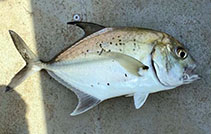| Family: |
Carangidae (Jacks and pompanos), subfamily: Caranginae |
| Max. size: |
66 cm TL (male/unsexed) |
| Environment: |
reef-associated; brackish; marine; depth range 7 - 63 m |
| Distribution: |
Southwest Pacific: Arafura Sea (Ref. 9819), northern Australia, from the Timor Sea in the west (Ref. 6905) to the Gulf of Papua in the north (Ref. 6906) and on the eastern coast of Australia as far south as Gladstone (Ref. 6907). |
| Diagnosis: |
|
| Biology: |
Adults are common in prawn trawling grounds and are most abundant closer to the coast. They feed predominantly on benthic prey consisting mainly of crustaceans and teleosts (Ref. 6908). They exhibit diel vertical migration, possibly following the movement of crustaceans along the water column. Continuous spawning during the year (Ref. 6904). Juveniles are often encountered in estuaries. Caught mainly on hook-and-line and by spearing; also with gill nets and other artisanal gear. This species is an excellent sports fish (Ref. 9894). |
| IUCN Red List Status: |
Least Concern (LC); Date assessed: 19 July 2017 Ref. (130435)
|
| Threat to humans: |
harmless |
Source and more info: www.fishbase.org. For personal, classroom, and other internal use only. Not for publication.
